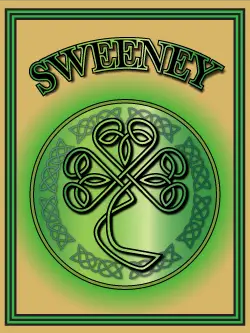There is some confusion about the origin of the name Sweeney amongst historians.
It is now a common name in most of the English-speaking world, with thousands of Sweeneys dotted around Ireland, the UK, the USA and beyond.
There are also several variations such as MacSweeney, MacSweeny, MacSwiney, MacSwiny, McSweeney, McSweeny, McSwiney, McSwiny, Sweeney, Sweeny, Sweny, Swain, Swiney, Swinney, and Swinnea.
Descendants of Niall of the Nine Hostages
Some believe it is an ancient Irish name, and others think it’s Scottish.
The truth is likely somewhere in between with the name itself originating in Scotland, but from the descendants of the Irish O’Neill clan, who in turn had descended from the legendary Niall of the Nine Hostages.
The origin can be traced back to the 11th century. Ánrothán Ua Néill was a prince of the O’Neill dynasty in Ireland. When the King of Ailech (the area now known as Donegal) died, Ánrothán was selected to take over.
He passed up the chance and installed his brother in the position instead. Ánrothán then travelled to Argyll to marry a daughter of the King of Scotland, and build his own powerful dynasty.
He did just that and several powerful Scottish clans descended from Ánrothán. One of which was the Mac Suibhnes.
Ánrothán’s great grandson was named Suibhne, a word meaning pleasant. He may have been given this name because of his nature, or even his physical appearance.
He became a clan leader, and his dynasty became known as the Mac Suibhne clan. The prefix Mac is an ancient Gaelic addition to a name. It means ‘the son of’, so the Mac Suibhne clan was borne out of the sons of Suibhne.
Forced to leave Scotland by Robert the Bruce
The Mac Suibhne remained a powerful family in Scotland up until the 14th century. They were forced from their territories around Argyll by Robert the Bruce’s sweep across the nation as he attempted to become King of Scotland.
The Mac Suibhnes attempted to take back their land but lacked an army strong enough to overpower Bruce. They were forced to leave for Ireland.
Once they settled in Ireland, the Mac Suibhnes split into three main clans; Mac Suibhne Fánad, Mac Suibhne na d’Tuath and Mac Suibhne Boghaineach.
The Fánad Mac Suibhnes
The Mac Suibhne Fánad established themselves around the northern coast of Donegal. Eoin Mac Suibhne removed the Ó Breisléin clan from the area and took control.
His daughter married the Ó Domnaill, king of Tír Conaill, and the two families formed an alliance.
The Mac Suibhnes na d’Tuath
The Mac Suibhne na d’Tuath settled in the north-west of Donegal and also took control of Tory Island which is just off the coast. In 1598, a descendent of the Mac Suibhne na d’Tuath named Maol Mhuire fought with the English in a battle with Red Hugh O’Donnell.
Mhuire and the English lost the battle and O’Donnell banished Mhuire from his land. He was however, knighted by the English as a reward for his service.
Later that same year, Mhuire entered into the conflict again, but this time fought for O’Donnell against the English. He was captured and imprisoned but managed to escape.
The Boghaineach Mac Suibhnes
Mac Suibhne Boghaineach took the territory to the south-west of County Donegal. Several battles and family betrayals followed which led to the leader of the dynasty changing hands numerous times.
In 1513, Killybegs (a town in the Mac Suibhne Boghaineach territory) was plundered by Eoghan Ó Máille with a mini-army of three ships. Ó Máille took prisoners from Killybegs and fled.
However, bad weather left the ships stranded off the coast, unable to venture out to sea, and unwilling to return to Killybegs.
The Mac Suibhne Boghaineach soldiers were away fighting in the O’Donnell army at the time. A youth called Brian Mac Suibhne set out to sea along with a handful of shepherds. He managed to kill Ó Máille and rescue the Killybegs prisoners.
Mac Suibhne evolved into Sweeney
All three of the Mac Suibhne clans were victims of Oliver Cromwell’s invasion of Ireland in the 16th century. They could not compete with the military strength of Cromwell and had their land taken and given to British settlers.
The name Mac Suibhne evolved into the more English sounding MacSweeney as the British integrated themselves into Irish society.
The name then changed further, dropping the ‘Mac’ prefix. People did this because it was difficult to find work if you had an Irish sounding name. The more English sounding Sweeney would have offered a better chance.
Thousands of Sweeneys left Ireland for Britain, American and Australia during the ‘Great Famine’ in the mid-19th century. It is now a popular name around the world.
